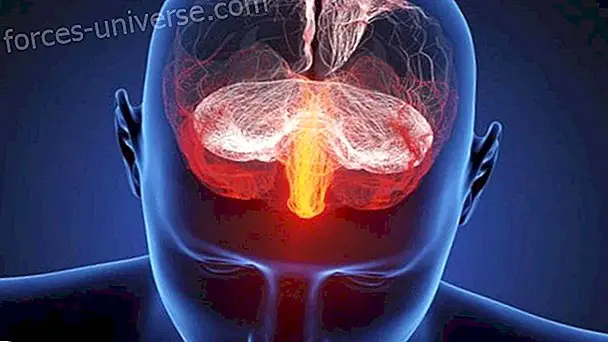EMDR: Psychological therapy based on the connection between our mind and our eyes
- 2018

"The face is the mirror of the soul, and the eyes its reporters."
- Cicero
We have all experienced difficult moments in our life . And many of these events have been burned into our psychology, affecting our performance and balance throughout life.
How many times do we find ourselves wishing that our life would be easier? How many do we realize that we are stuck without being able to continue with our life?
Fortunately, there are more and more advances in the discovery of new therapies that help people balance their emotional state .
From various approaches, science and spirituality accompany us in various ways so that we can find balance and be able to continue with our life in a normal way.
This is also the object of EMDR Therapy, initiated by Francine Shapiro in 1987, and which we will talk about in this article.
EMDR: The importance in emotional balance
We all also know, to a greater or lesser extent, the symptoms and consequences of not finding ourselves emotionally balanced .
Emotions are a very big tool on our way to success, but they can also be a real punishment. If you don't balance and learn to regulate emotions, we can completely lose your sense of motivation. The days are repeated one by one without much interest. One has neither strength nor desire to get out of bed. It can take us completely away from people who are important to us.
The body also suffers the damage of emotional imbalance .
That way we predispose ourselves to diseases of all kinds, without finding the apparent cause, which makes them in turn more difficult to treat. Diabetes, hypothyroidism and cancer are common diseases with emotional roots.
This is where EMDR comes in.
EMDR: A little history
Francine Shapiro is the American psychologist and educator who developed EMDR therapy (for the acronym of Desensitization and Reprocessing by Eye Movements). As she tells us, during a walk in the park she discovered that moving her eyes from side to side apparently reduced the appearance of negative thoughts and memories .
This experience was the trigger that led her to examine this phenomenon more systematically.
In this way, he began his studies with volunteers who were victims of major traumas, and carrying out a standardized procedure to maximize the certainty of their conclusions. Needless to say, the results he obtained were decisive.
This is the birth of EMDR therapy, which has helped thousands of people in the fight against post-traumatic stress.

EMDR: Healing the psychological wounds
When we injure one arm, our body has a mechanism that acts immediately to deal with that trauma or physical injury. That is the power of self - healing of our body. Now, if the injury is caused by the presence of a foreign object or occurs repeatedly, ulcers are generated that can remain for a prolonged period of time. They burn, hurt and compromise our physical balance.
In the same way, our mind also has the ability to heal itself from injuries and traumas caused by past events. This mechanism of self - healing of the mind also acts immediately in the face of trauma. But when it is subjected to our mind to the punishment of being exposed to that trauma in a repetitive manner or when it does not heal properly, this object extra o to us can generate a series of imbalances in our natural balance.
That way, the mind's self-healing power would be impeded by this presence, and this could be extended for a long time.
EMDR, then, guides us on the path to free our minds from these imbalances, so that we can heal our wounds and reach a state of balance and consequently greater well-being in our lives.
Connection between our eyes and our mind
Our eyes and our mind have a very close relationship. They are part of one of the most important channels in our perception system. They have the ability to interpret the information around us immediately and therefore play a fundamental role in the way we structure our reality .
In the same way, this connection occurs both ways. That is, also what happens in our eyes is a reaction to what happens in our mind.
That is why we have the ability to interpret a message beyond words, simply looking into the eyes of the person speaking to us . If it blinks a lot, if it hides the look, if it has dilated pupils. These are all indicators of a process that is taking place at the mental level.
In the same way, the movement of the eyes is a less intuitive but equally concrete indicator of what happens in our head. These patterns show the connections with sensations and emotions that are made when expressing ourselves. In fact, the keys of ocular access is one of the contributions that NeuroLinguistic Programming has given to interpersonal knowledge.

EMDR: How it works
EMDR therapy consists of a treatment that is divided into eight phases. Within this procedure, eye movements (or bilateral stimulation) is only a fraction of the process.
During the first phase, the patient tells the story of his trauma. In that way, the therapist can develop a plan to address the treatment, identifying the objectives of EMDR. These objectives are oriented to events of the past that condition their behavior.
The second phase of treatment is the moment when the therapist makes sure of the different behaviors that reflect the patient's conflict. In this way, he can teach you some simple techniques to reduce the stress that the individual should use throughout the different sessions, and during his daily routine as well.
During phases three to six, the objective is identified and processed using the different EMDR procedures. These are oriented in that the patient can identify the vivid image related to his memory, the negative belief about himself and the emotions and bodily sensations related to that event.
Then, the patient focuses on these three things while carrying out EMDR processes such as bilateral eye movement (the duration of this moment varies in each person). Then, the patient must put his mind blank and be attentive to the thoughts, emotions, memories and images that are awakened in his mind.
That way, the therapist will determine the next focus of attention.
During the seventh phase, the closure, the EMDR therapist asks the patient to keep a diary for a week in which they write down everything that happens related to this event. In this way, the individual does not lose the focus of the treatment during his daily routine.
The next session will begin with phase eight, in which the results and progress so far are examined.
EMDR therapy is based on events that occur in the historical past of the person. In those incidents that happen at some point in our life and cause a change of course . A before and after them.
We are all victims and products of our own history.
And we all have the tools to create our story by deciding what to do from the events that occur in our lives. Therapy is one of them.
Choose your path, and if you need it, seek help to provoke your results.
AUTHOR: Lucas, editor of the great family of HermandadBlanca.org
SOURCES:
- https://en.wikipedia.org/wiki/Francine_Shapiro
- http://www.emdr.com/history-of-emdr/
- https://en.wikipedia.org/wiki/Eye_movement_desensitization_and_reprocessing
- http://www.emdr.com/what-is-emdr/
- http://narceaeduplastica.weebly.com/el-ojo-y-la-mente.html
- https://psicologiaymente.com/social/leer-ojos






